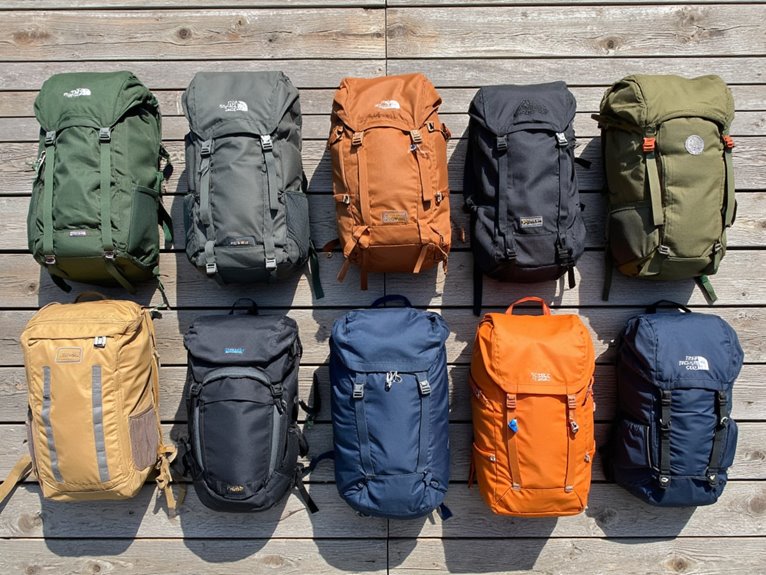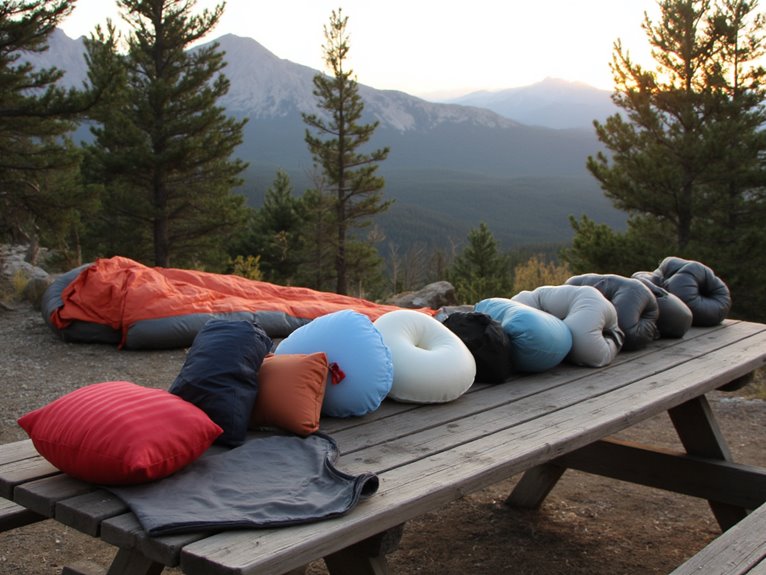Can You Spray a Backpack to Make It Waterproof?
Yes, you can spray a backpack to make it waterproof, and doing so can substantially improve its durability and performance in wet conditions. Waterproofing sprays create an invisible shield that prevents water from penetrating the material, making them ideal for outdoor gear and equipment. When choosing a spray, consider the type of fabric, intended use, and desired level of protection. By applying a waterproofing spray correctly, you can enjoy outdoor activities with confidence. To guarantee the best results and avoid common mistakes, it's crucial to understand the best practices for application and the different types of waterproofing sprays available – there's more to discover.
We are supported by our audience. When you purchase through links on our site, we may earn an affiliate commission, at no extra cost for you. Learn more. Last update on 28th December 2025 / Images from Amazon Product Advertising API.
What Are Waterproofing Sprays?
Waterproofing sprays are specialized coatings designed to repel water and moisture, providing a protective barrier against the elements for a variety of surfaces, including fabrics, leather, and synthetic materials.
These sprays create an invisible shield that prevents water from penetrating the material, making them ideal for outdoor gear, clothing, and equipment.
Waterproofing sprays are commonly used to treat backpacks, tents, shoes, and clothing, ensuring they remain dry and functional in wet conditions.
By applying a waterproofing spray, users can enjoy outdoor activities with confidence, knowing their gear is protected from the elements.
With various types of waterproofing sprays available, it's essential to choose the right one for the specific material and intended use.
How Do Waterproofing Sprays Work?
When applied to a surface, waterproofing sprays form a thin, invisible layer that alters the material's surface tension, causing water to bead up and roll off instead of penetrating the fabric.
This hydrophobic (water-repelling) effect is achieved through the spray's unique chemical composition.
Some key benefits of waterproofing sprays include:
- Reduced water absorption: The treated surface repels water, preventing it from seeping into the fabric.
- Improved durability: By reducing water absorption, the material's lifespan is extended.
- Easy maintenance: Waterproofing sprays make cleaning easier, as dirt and stains can be simply wiped away.
- Breathability: The treated surface remains breathable, allowing moisture to escape while keeping water out.
Types of Waterproofing Sprays Available
Several types of waterproofing sprays are available on the market, each formulated to cater to specific needs and surfaces.
Silicone-based sprays provide a breathable, flexible barrier against water and are suitable for most backpack materials.
Fluoropolymer-based sprays offer superior water repellency and are ideal for nylon, polyester, and other synthetic fabrics.
Wax-based sprays, often used for cotton and canvas, create a hydrophobic coating that causes water to bead up and roll off.
Some sprays are specifically designed for UV resistance, stain resistance, or extreme weather conditions.
When choosing a waterproofing spray, consider the type of fabric, intended use, and desired level of protection to select the most effective product for your backpack.
Pros and Cons of Waterproofing Sprays
While waterproofing sprays offer numerous benefits, they also have some drawbacks that must be considered before application.
Breathability: Waterproofing sprays can compromise the breathability of your backpack's fabric, potentially leading to moisture buildup and reduced performance.
Durability: Some sprays may not be as durable as others, requiring reapplication after a few uses or in harsh conditions.
Compatibility: Not all waterproofing sprays are compatible with all fabric types, so be sure to choose a spray suitable for your backpack's material.
Environmental impact: Some sprays may contain chemicals that can harm the environment, so consider eco-friendly options.
Best Practices for Application
To guarantee effective waterproofing and minimize potential drawbacks, it is vital to follow best practices when applying a waterproofing spray to your backpack.
Before application, verify the backpack is clean and dry, with all loose dirt and debris removed.
Choose a well-ventilated area and apply the spray in thin, even coats, following the manufacturer's instructions.
Avoid over-saturating the fabric, as this can compromise the material's breathability.
Apply the spray in a consistent, back-and-forth motion, covering all surfaces evenly.
Allow the first coat to dry completely before applying additional coats.
Testing the Effectiveness of Sprays
To verify the effectiveness of waterproofing sprays, rigorous methods must be utilized to guarantee the spray's performance meets expectations.
This involves evaluating the spray's ability to repel water through standardized testing protocols, such as immersing the treated fabric in water or subjecting it to simulated rainfall.
Spray Application Methods
Proper spray application is essential to achieving a waterproof backpack, and various methods can greatly impact the effectiveness of the waterproofing spray. The method of application can substantially influence the level of waterproofing achieved.
Hold the can 6-8 inches away from the backpack and move it back and forth to guarantee even coverage.
Apply a thin, consistent layer to avoid pooling or running of the spray.
Spray in a well-ventilated area to prevent inhalation of fumes.
Allow the first coat to dry completely before applying additional coats for maximum effectiveness.
Water Resistance Testing
Reliability in water resistance testing is essential to ensuring the effectiveness of waterproofing sprays, as it directly correlates to the level of protection afforded to the backpack.
To accurately assess the efficacy of a waterproofing spray, a standardized testing protocol should be employed. This includes simulating real-world conditions, such as rain or immersion, and evaluating the backpack's water resistance using metrics like water absorption, penetration, and permeability.
Additionally, testing should be conducted on both treated and untreated backpacks to establish a control group for comparison. By adopting a rigorous testing methodology, users can confidently determine the effectiveness of waterproofing sprays and make informed decisions about their backpack's protection.
Alternative Methods for Waterproofing
In addition to spray-on waterproofing treatments, several alternative methods exist for protecting your backpack from moisture, including waterproof backpack liners, rain covers, and DIY mods.
These alternatives can provide an added layer of protection against the elements, ensuring your gear stays dry in wet conditions.
Some popular alternative methods for waterproofing a backpack include:
Waterproof backpack liners: These are inserted into the backpack to create a waterproof compartment.
Rain covers: These are lightweight and compact covers that can be easily deployed in rainy conditions.
DIY mods: Creative backpackers can modify their backpacks with waterproof materials, such as silnylon or nylon, to create a more water-resistant design.
Waterproof pockets: Adding waterproof pockets or compartments to your backpack can provide an extra layer of protection for sensitive items.


